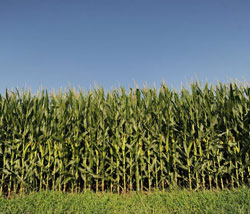The sugarcane harvest in Brazil is running ahead of schedule and the U.S. corn crop is progressing well, according to the latest reports.
 The cane crush in Brazil so far this year is running about 20 percent ahead of last year, which is not necessarily good news according to the Brazilian Sugarcane Industry Association’s (UNICA). Technical Director Antonio de Padua Rodrigues says the additional crushing observed so far can be attributed to the early start of the current harvest. Drier weather this year compare to last year has increased the harvesting pace, but it also may reduce the biomass potential of the cane yet to be harvested.
The cane crush in Brazil so far this year is running about 20 percent ahead of last year, which is not necessarily good news according to the Brazilian Sugarcane Industry Association’s (UNICA). Technical Director Antonio de Padua Rodrigues says the additional crushing observed so far can be attributed to the early start of the current harvest. Drier weather this year compare to last year has increased the harvesting pace, but it also may reduce the biomass potential of the cane yet to be harvested.
About half of the Brazil harvest is going to ethanol and half to sugar. UNICA reports that sugar production totaled 2.50 million tons in the first half of July, 25.75% higher than in 2009 during the same two-week period. Ethanol production also increased by 25.28% over the same period, reaching 1.86 billion liters.
Ethanol exports from Brazil are down this year, but domestic use is strong, according to Rodrigues. “The demand for ethanol fuel is rising, as flex-fuel vehicle sales remain high. Moreover, domestic ethanol consumption for other purposes will set new records during this harvest, mainly because of higher demand for the ethanol as a raw material for chemicals production.”
 Meanwhile, here in the U.S., ethanol production was up 14,000 barrels per day in May, according to the Energy Information Administration (EIA), at more than 846,000 barrels. Ethanol demand, as calculated by the Renewable Fuels Association, also reached an all time high at 847,000 b/d in May, up from 713,000 b/d a year ago.
Meanwhile, here in the U.S., ethanol production was up 14,000 barrels per day in May, according to the Energy Information Administration (EIA), at more than 846,000 barrels. Ethanol demand, as calculated by the Renewable Fuels Association, also reached an all time high at 847,000 b/d in May, up from 713,000 b/d a year ago.
On the import/export side, EIA reports that U.S. ethanol imports were up slightly from April at 1.6 million gallons, but exports were down dramatically – from 40.8 million gallons to just over 17 million. As of May, the U.S. has exported a total of 141.4 million gallons this year, but RFA notes that export figures represent the sum of “Ethyl alcohol and other spirits, denatured, of any strength” and “Undenatured ethyl alcohol of an alcoholic strength by volume of 80 percent vol. or higher.” As such, the figures likely include ethyl alcohol exports for non-fuel industrial purposes, so RFA ethanol demand calculations are for domestic use only, providing a comparison to domestic ethanol production.
The U.S. corn crop continues to look good and some farmers are expecting to start harvest earlier than normal. According to the latest USDA report, 93% of the crop is silking, compare to 86% on average, over 30 percent in the dough stage and 7% dented, both ahead of normal. Despite the heat, the condition of the crop is holding steady at more than 70 percent good to excellent.

